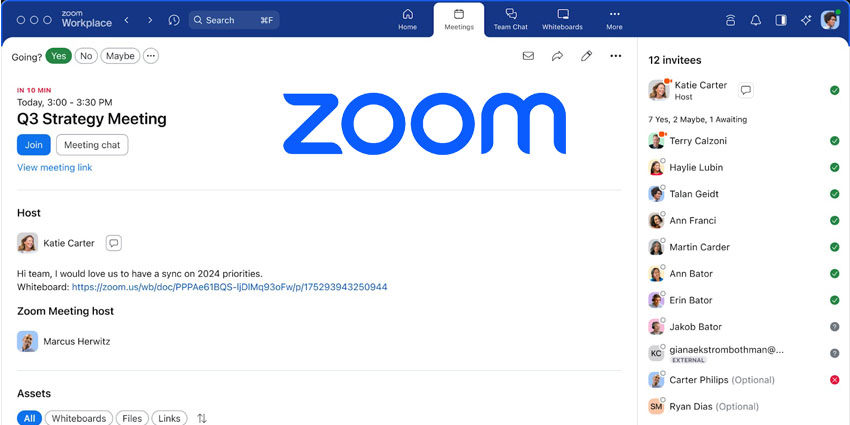2019 was the year Artificial Intelligence and strategic partnerships took center stage at Microsoft Ignite. This was clear from day one when Microsoft and Cisco announced plans to launch a way for Webex video devices to connect with Microsoft Teams in 2020. Microsoft also launched a ton of new features for Teams, including secure private channels, multi-window chats, meetings, pinned channels, and task integration.
Microsoft Teams will soon support Zoom Meetings, and the Teams Phone System is adding emergency calls. Of all the features Microsoft added to Microsoft Teams, among the most powerful was secure private channels. Microsoft Teams is the fastest-growing business app in Microsoft history, and the demand for private channels has become one of the most requested features, according to John Peluso, Microsoft Regional Director, and CTO, Public Sector at AvePoint. He said private channels will give admins more control over who can / can’t access content and sensitive materials, adding the process would become more secure.
“The introduction of private channels will solve widespread problems with how large teams communicate and improve security”
What else defined this year’s Ignite event and what key Microsoft announcements might you have missed last week? There’s a lot to cover, so I’ll dive right in.
1. Cooperation is Key
As mentioned, Microsoft and Cisco last week announced plans to launch a new way for Webex Teams and Microsoft Teams users to connect. In teaming up, the duo showcased a commitment to enhancing customer and user experience. They likely realized the amount of crossover between Microsoft Teams and Cisco Webex Teams users and wanted to provide a way for them to connect seamlessly. Cisco will first introduce the Microsoft third-party certified offering, which enables Webex Room devices and SIP video conferencing devices to join Microsoft Teams meetings.
As a growing number of enterprise collaboration tool developers realize the importance of working together, the move is regarded as wise. And many industry experts took to social media to express their views during Ignite. The sentiment on Twitter, that of excitement.
Microsoft also announced a new partnership with Poly – launching a set of advanced huddle room devices with a ton of useful features – including a dedicated Teams button. The devices run on the latest Android OS and have built-in USB A, USB C, Bluetooth, and WiFi. The devices will be available with or without a handset, but the USB port does allow users to connect handsets. In a blog post on Poly’s site, the manufacturer wrote about the new partnership:
“As more and more customers migrate to Microsoft Teams, one thing is for sure, Poly and partners have created a one-stop-shop for your customers as they make the journey to Microsoft Teams for both personal and group collaboration needs”
The post continued, stating, Poly was not out to offer the most features, but the best features for unified communications and collaboration products that power Microsoft Teams experiences.
Microsoft also launched ‘Collaboration Bars,’ with hopes to revolutionize the way we imagine huddle rooms. They want end-users to think of the spaces as fully productive areas for virtual collaboration with new endpoints that attach to displays to create a high-quality video meeting experiences in seconds. The plan is to launch the devices in conjunction with Yealink in 2020. Microsoft and Poly even plan to launch a set of speakerphones. Also available in conjunction with Yealink, the CP900 works in the Microsoft Teams environment.
All this shows enterprise leaders Microsoft is willing to reach across the aisle and work with other collaboration enablers for the sake of CX. Also during Ignite, Microsoft introduced a new phone system with advanced features like call queue, emergency calls, as well as administrative control. The appeal for enterprise customers – new compliance call recording capabilities.
2. An Easy No-Code Way to Enhance Omni-channel
At Ignite, Microsoft recognized enterprise leaders wanted to use the latest machine learning technology to deliver conversational AI experiences tailored to their brands. The challenge, though, knowing where AI can enhance CX and best assist live agents in doing their job while providing little friction for everyone involved in the customer journey.
As such, Microsoft declared its intent to launch ‘Power Virtual Agent,’ a no-code platform for building chatbots. The new tool will rely on Azure’s Artificial Intelligence functionalities to make building conversational AI simple.
3. Microsoft Disrupts Small Business Comms in the UK
Capitalizing on another strategic market during Ignite week, Microsoft disrupted the UK’s small business (up to 300 users) communications market. How’d they do it? They introduced ‘Microsoft 365 Business Voice,’ as my colleague Rebekah Carter reported last week.
The solution combines chat, calling, meetings, calendars, and email – all bundled for enterprise-grade collaboration and communications. The offering is geared toward smaller businesses and suitable for up to 300 users. Based in the cloud, the business phone system integrates with Teams and Office 365 to deliver an experience that works across all devices. This includes smartphones, desk phones, and computers – enabling calling from anywhere there’s an internet connection.
Microsoft’s novel application of AI in contact centers is capable of translating chat messages, transcribing voicemails, and providing real-time captioning in meetings, chats, etc. The software development giant does say it has bigger plans for the offering, however, and says it will launch the low-cost business voice service globally in 2020. When Microsoft does, it will permanently alter the business voice landscape for the better.
Wow, That Was A Lot
I know that was a lot to take in. Just imagine how reporters and developers felt with the constant barrage of news coming from Microsoft last week. The consensus is – Microsoft outdid itself, and next year, I predict will be even bigger. I, for one, am looking forward to the forward-thinking leadership of those on the frontlines developing next-generation Microsoft Teams features.
The only question that remains is what can we expect from next year’s Microsoft Ignite? If we learned anything this year, it is that Microsoft will continue its crusade to dominate the collaboration space through superior user experiences. It will do so via a wide range of meeting room and contact center devices, along with software designed to deliver such experiences.







